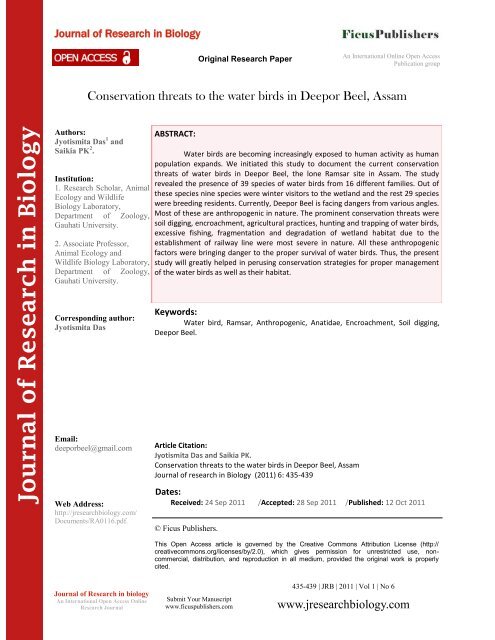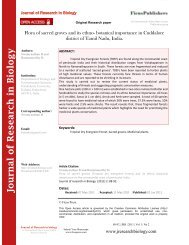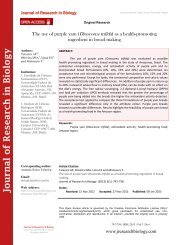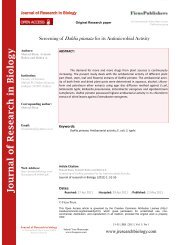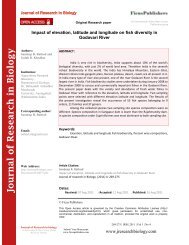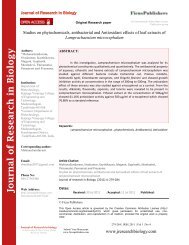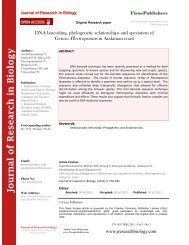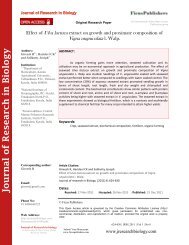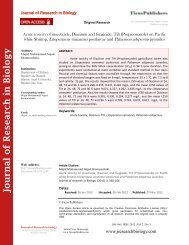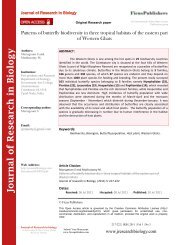Conservation threats to the water birds in Deepor Beel, Assam
Conservation threats to the water birds in Deepor Beel, Assam
Conservation threats to the water birds in Deepor Beel, Assam
You also want an ePaper? Increase the reach of your titles
YUMPU automatically turns print PDFs into web optimized ePapers that Google loves.
Journal of Research <strong>in</strong> Biology<br />
Journal of Research <strong>in</strong> Biology<br />
<strong>Conservation</strong> <strong>threats</strong> <strong>to</strong> <strong>the</strong> <strong>water</strong> <strong>birds</strong> <strong>in</strong> <strong>Deepor</strong> <strong>Beel</strong>, <strong>Assam</strong><br />
Authors:<br />
Jyotismita Das 1 and<br />
Saikia PK 2 .<br />
Institution:<br />
1. Research Scholar, Animal<br />
Ecology and Wildlife<br />
Biology Labora<strong>to</strong>ry,<br />
Department of Zoology,<br />
Gauhati University.<br />
2. Associate Professor,<br />
Animal Ecology and<br />
Wildlife Biology Labora<strong>to</strong>ry,<br />
Department of Zoology,<br />
Gauhati University.<br />
Correspond<strong>in</strong>g author:<br />
Jyotismita Das<br />
Email:<br />
deeporbeel@gmail.com<br />
Web Address:<br />
http://jresearchbiology.com/<br />
Documents/RA0116.pdf.<br />
Journal of Research <strong>in</strong> biology<br />
An International Open Access Onl<strong>in</strong>e<br />
Research Journal<br />
ABSTRACT:<br />
Water <strong>birds</strong> are becom<strong>in</strong>g <strong>in</strong>creas<strong>in</strong>gly exposed <strong>to</strong> human activity as human<br />
population expands. We <strong>in</strong>itiated this study <strong>to</strong> document <strong>the</strong> current conservation<br />
<strong>threats</strong> of <strong>water</strong> <strong>birds</strong> <strong>in</strong> <strong>Deepor</strong> <strong>Beel</strong>, <strong>the</strong> lone Ramsar site <strong>in</strong> <strong>Assam</strong>. The study<br />
revealed <strong>the</strong> presence of 39 species of <strong>water</strong> <strong>birds</strong> from 16 different families. Out of<br />
<strong>the</strong>se species n<strong>in</strong>e species were w<strong>in</strong>ter visi<strong>to</strong>rs <strong>to</strong> <strong>the</strong> wetland and <strong>the</strong> rest 29 species<br />
were breed<strong>in</strong>g residents. Currently, <strong>Deepor</strong> <strong>Beel</strong> is fac<strong>in</strong>g dangers from various angles.<br />
Most of <strong>the</strong>se are anthropogenic <strong>in</strong> nature. The prom<strong>in</strong>ent conservation <strong>threats</strong> were<br />
soil digg<strong>in</strong>g, encroachment, agricultural practices, hunt<strong>in</strong>g and trapp<strong>in</strong>g of <strong>water</strong> <strong>birds</strong>,<br />
excessive fish<strong>in</strong>g, fragmentation and degradation of wetland habitat due <strong>to</strong> <strong>the</strong><br />
establishment of railway l<strong>in</strong>e were most severe <strong>in</strong> nature. All <strong>the</strong>se anthropogenic<br />
fac<strong>to</strong>rs were br<strong>in</strong>g<strong>in</strong>g danger <strong>to</strong> <strong>the</strong> proper survival of <strong>water</strong> <strong>birds</strong>. Thus, <strong>the</strong> present<br />
study will greatly helped <strong>in</strong> perus<strong>in</strong>g conservation strategies for proper management<br />
of <strong>the</strong> <strong>water</strong> <strong>birds</strong> as well as <strong>the</strong>ir habitat.<br />
Keywords:<br />
Water bird, Ramsar, Anthropogenic, Anatidae, Encroachment, Soil digg<strong>in</strong>g,<br />
<strong>Deepor</strong> <strong>Beel</strong>.<br />
© Ficus Publishers.<br />
Orig<strong>in</strong>al Research Paper<br />
Article Citation:<br />
Jyotismita Das and Saikia PK.<br />
<strong>Conservation</strong> <strong>threats</strong> <strong>to</strong> <strong>the</strong> <strong>water</strong> <strong>birds</strong> <strong>in</strong> <strong>Deepor</strong> <strong>Beel</strong>, <strong>Assam</strong><br />
Journal of research <strong>in</strong> Biology (2011) 6: 435-439<br />
An International Onl<strong>in</strong>e Open Access<br />
Publication group<br />
Dates:<br />
Received: 24 Sep 2011 /Accepted: 28 Sep 2011 /Published: 12 Oct 2011<br />
This Open Access article is governed by <strong>the</strong> Creative Commons Attribution License (http://<br />
creativecommons.org/licenses/by/2.0), which gives permission for unrestricted use, noncommercial,<br />
distribution, and reproduction <strong>in</strong> all medium, provided <strong>the</strong> orig<strong>in</strong>al work is properly<br />
cited.<br />
435-439 | JRB | 2011 | Vol 1 | No 6<br />
Submit Your Manuscript<br />
www.ficuspublishers.com www.jresearchbiology.com
INTRODUCTION<br />
Human conflicts with animals go back at<br />
least as far as humans have been a species<br />
(Cansdale 1952, Fisher and Lockley, 1954). Birds<br />
are widely recognized as good bio<strong>in</strong>dica<strong>to</strong>rs of <strong>the</strong><br />
quality of ecosystems (Gill, 1994) and health of <strong>the</strong><br />
environment. Kumar et al. (2006) gives a clear<br />
status of wetland <strong>birds</strong> <strong>in</strong> his work. Wetland <strong>birds</strong><br />
play a significant cultural and social role <strong>in</strong> local<br />
communities as well as be<strong>in</strong>g an important<br />
component of wetland ecosystem (Kumar et al.<br />
2006). Due <strong>to</strong> cont<strong>in</strong>uous degradation of wetland<br />
ecosystems, it becomes a great matter of concern<br />
regard<strong>in</strong>g <strong>the</strong> status of wetland dependent <strong>birds</strong>.<br />
Increas<strong>in</strong>g attention of conservation of this <strong>water</strong><br />
bodies br<strong>in</strong>gs an extensive research <strong>to</strong> this field.<br />
<strong>Deepor</strong> <strong>Beel</strong> which is <strong>the</strong> lone Ramsar site of<br />
<strong>Assam</strong> is fac<strong>in</strong>g danger from various angles <strong>in</strong> this<br />
regard. In this study, attempt had been made <strong>to</strong><br />
identify <strong>the</strong> current conservation <strong>threats</strong> <strong>to</strong> <strong>the</strong> <strong>water</strong><br />
<strong>birds</strong> <strong>in</strong> and around <strong>the</strong> <strong>Beel</strong> periphery. Thus <strong>the</strong><br />
study provides immense scope <strong>in</strong> conservation of<br />
<strong>the</strong> <strong>water</strong> <strong>birds</strong> and its habitat. The importance of<br />
w<strong>in</strong>ter<strong>in</strong>g areas <strong>in</strong> <strong>the</strong> dynamics of <strong>water</strong> bird<br />
populations is suggested by <strong>the</strong> potentially crucial<br />
role <strong>the</strong>se areas play <strong>in</strong> courtship or pair<strong>in</strong>g and<br />
deposition of fat s<strong>to</strong>res used later as energy for<br />
reproduction (Heitmeyer and Fredrickson, 1981;<br />
James, 1989; Baldassarrea and Bolen, 1994).<br />
W<strong>in</strong>ter habitat quality has been l<strong>in</strong>ked <strong>to</strong> annual<br />
survival recruitment, and reproductive success of<br />
<strong>water</strong>fowl (Baldassarre and Bolen, 1994).The area<br />
has not received much attention especially from <strong>the</strong><br />
biological po<strong>in</strong>t of view Bera et al.2008). The<br />
present correspondence is an attempt regard<strong>in</strong>g<br />
conservation and preservation of <strong>the</strong> lone Ramsar<br />
site of <strong>Assam</strong> by identify<strong>in</strong>g different threat fac<strong>to</strong>rs<br />
prevail<strong>in</strong>g <strong>in</strong> and with<strong>in</strong> <strong>the</strong> <strong>Beel</strong> periphery.<br />
MATERIAL AND METHODS<br />
Study area<br />
<strong>Deepor</strong> <strong>Beel</strong> is a large natural wetland<br />
hav<strong>in</strong>g great biological and environmental<br />
importance (Deka and Goswami, 1992). This large<br />
<strong>water</strong> body is a great food source and breed<strong>in</strong>g<br />
ground for a variety of migra<strong>to</strong>ry <strong>birds</strong>, amphibians,<br />
reptiles, <strong>in</strong>sects, micro and macrophytes, terrestrial<br />
weeds and important taxa of ecological and<br />
economic importance (Bera et al. 2008). The<br />
<strong>Deepor</strong> <strong>Beel</strong> Ramsar site has a <strong>to</strong>tal area of 40 Km 2<br />
of which 4.14 Km 2 had declared as a Bird Sanctuary<br />
(Das et al. 2011). In November 2002, it was listed<br />
as a Ramsar site ow<strong>in</strong>g <strong>to</strong> its rich wetland<br />
Jyotismita et al.,2011<br />
biodiversity and sociocultural importance. Aga<strong>in</strong>,<br />
consider<strong>in</strong>g <strong>the</strong> varieties of bird species found <strong>in</strong><br />
<strong>the</strong> <strong>Beel</strong>, Birdlife International has also declared<br />
<strong>Deepor</strong> <strong>Beel</strong> as an Important Bird Area (IBA). At<br />
maximum flood<strong>in</strong>g <strong>the</strong> <strong>Beel</strong> becomes above four<br />
meters <strong>in</strong> deep and dur<strong>in</strong>g <strong>the</strong> dry season <strong>the</strong> depth<br />
drops <strong>to</strong> about 1-1.5 meter. <strong>Deepor</strong> <strong>Beel</strong><br />
(Coord<strong>in</strong>ation: 26°03′26″–26°09′26″N and 90°36′<br />
39″–90°41′25″E) is situated on <strong>the</strong> Sou<strong>the</strong>rn bank<br />
of <strong>the</strong> river Brahmaputra and Village Maj Jalukbari,<br />
Pachim Jalukbari, Dharapur and National Highway<br />
No.37 lie on <strong>the</strong> North; Dakh<strong>in</strong> Jalukbari, Tetelia<br />
and Pachim Baragoan <strong>to</strong> <strong>the</strong> East; Gorbhanga<br />
Reserve Forest, Chakardew Hill and Chilla Hill <strong>to</strong><br />
<strong>the</strong> South West and <strong>the</strong> Village Azara and<br />
Kahikuchi <strong>to</strong> <strong>the</strong> west. <strong>Deepor</strong> <strong>Beel</strong> has a meso<strong>the</strong>rmal<br />
climate. The temperature ranges between<br />
10.6°C <strong>to</strong> 32°C. <strong>Deepor</strong> <strong>Beel</strong> appears <strong>to</strong> be<br />
relatively high with respect <strong>to</strong> <strong>the</strong> biodiversity of<br />
free float<strong>in</strong>g, emergent and submerged aquatic<br />
macrophyte (Saikia and Bhattacharjee, 1987).<br />
Avian data as well as data on threat fac<strong>to</strong>rs<br />
were collected from March 2007 <strong>to</strong> March 2010.<br />
For watch<strong>in</strong>g, count<strong>in</strong>g and identify<strong>in</strong>g <strong>birds</strong><br />
B<strong>in</strong>ocular (10X50), telescope (25-40X), camera<br />
(Cannon 110 PS), note book, guide book, pen,<br />
pencil etc were used. Birds were identified by<br />
see<strong>in</strong>g <strong>the</strong>ir characteristics feature <strong>in</strong> accordance<br />
with <strong>the</strong> identification keys <strong>in</strong>volved <strong>in</strong> Ali and<br />
Ripley (1983), Grimmett et al. (1999). Data on<br />
threat fac<strong>to</strong>rs were collected by direct observation,<br />
personal <strong>in</strong>terviews.<br />
RESULTS<br />
The present survey reveals <strong>the</strong> presence of<br />
38 species of <strong>water</strong> <strong>birds</strong> from 16 different families<br />
(Table 1).Of all <strong>the</strong>se n<strong>in</strong>e species were species are<br />
w<strong>in</strong>ter visi<strong>to</strong>rs <strong>to</strong> <strong>the</strong> wetland and <strong>the</strong> rest 29 species<br />
were breed<strong>in</strong>g residents. The study also<br />
documented <strong>the</strong> presence of endangered, vulnerable<br />
and Schedule I species under <strong>the</strong> Wildlife<br />
Protection Act, 1972. These are greater adjutant<br />
s<strong>to</strong>rk, lesser adjutant s<strong>to</strong>rk and large whistl<strong>in</strong>g teal<br />
etc.<br />
The study documented different threat<br />
fac<strong>to</strong>rs which were cont<strong>in</strong>uously prevail<strong>in</strong>g with<strong>in</strong><br />
<strong>the</strong> <strong>Beel</strong> periphery. Most of <strong>the</strong>se fac<strong>to</strong>rs were<br />
anthropogenic <strong>in</strong> nature. Soil digg<strong>in</strong>g,<br />
encroachment, agricultural practices around <strong>the</strong><br />
<strong>Beel</strong>, hunt<strong>in</strong>g and trapp<strong>in</strong>g of <strong>water</strong> <strong>birds</strong>, excessive<br />
fish<strong>in</strong>g, habitat fragmentation for <strong>the</strong> construction<br />
of railway l<strong>in</strong>e, brick mak<strong>in</strong>g fac<strong>to</strong>ries with<strong>in</strong> <strong>the</strong><br />
<strong>Beel</strong> ecosystem was <strong>the</strong> prom<strong>in</strong>ent threat fac<strong>to</strong>rs<br />
436 Journal of Research <strong>in</strong> Biology (2011) 6: 435-439
Jyotismita et al.,2011<br />
which are cont<strong>in</strong>uously prevail<strong>in</strong>g <strong>in</strong> and with<strong>in</strong> <strong>the</strong><br />
<strong>Beel</strong> periphery. Encroachment <strong>in</strong> various forms like<br />
house construction and o<strong>the</strong>r development activities<br />
were degrad<strong>in</strong>g <strong>the</strong> <strong>Beel</strong> ecosystem <strong>in</strong> utmost level.<br />
For construction and developmental works people<br />
were engaged <strong>to</strong> clear <strong>the</strong> aquatic vegetation which<br />
is very important for <strong>the</strong> survival of <strong>water</strong> <strong>birds</strong><br />
<strong>in</strong>habit<strong>in</strong>g <strong>the</strong>re. Apart from this, soil digg<strong>in</strong>g<br />
processes were carried out day and night with<strong>in</strong> <strong>the</strong><br />
<strong>Beel</strong> for fulfill<strong>in</strong>g <strong>the</strong> need of people. The <strong>in</strong>tensity<br />
of soil digg<strong>in</strong>g was documented high with<strong>in</strong> <strong>the</strong><br />
<strong>Beel</strong>. Different people were engaged <strong>in</strong> this work<br />
apart from us<strong>in</strong>g heavy vehicles for <strong>the</strong><br />
transportation of soil <strong>to</strong> different localities. Thus, it<br />
was seen that <strong>the</strong> <strong>Beel</strong> bed was digged out <strong>in</strong><br />
extreme level and <strong>water</strong> <strong>birds</strong> were forced <strong>to</strong> leave<br />
<strong>the</strong> <strong>Beel</strong> ecosystem. In w<strong>in</strong>ter season many <strong>water</strong><br />
<strong>birds</strong> were illegally netted by us<strong>in</strong>g various nets and<br />
traps. Aga<strong>in</strong> <strong>Deepor</strong> <strong>Beel</strong> acts as a stag<strong>in</strong>g ground<br />
for w<strong>in</strong>ter migra<strong>to</strong>ry <strong>birds</strong>. Many migra<strong>to</strong>ry and<br />
local breed<strong>in</strong>g ducks were netted down illegally<br />
which br<strong>in</strong>gs major threat <strong>to</strong> <strong>the</strong>ir survival.<br />
TABLE 1. List of <strong>the</strong> name of <strong>the</strong> <strong>water</strong> <strong>birds</strong> of <strong>Deepor</strong> <strong>Beel</strong> along with <strong>the</strong>ir scientific names<br />
Common Name Scientific Name Family Comments<br />
Large whistl<strong>in</strong>g teal Dendrocygna bicolor Anatidae Br(*)<br />
Lesser whistl<strong>in</strong>g teal Dendrocygna javanica Anatidae Br<br />
Gaganey Anas querquedula Anatidae Wv(**)<br />
Nor<strong>the</strong>rn P<strong>in</strong>tail Anas acuta Anatidae Wv<br />
Red crested poachard Rhodonessa ruf<strong>in</strong>a Anatidae Wv<br />
Ruddy shellduck Tadorna ferrug<strong>in</strong>ea Anatidae Wv<br />
Mallard Anas platyrhynchos Anatidae Wv<br />
Little egret Egretta garzetta Ardeidae Br<br />
Great egret Casmerodius albus Ardeidae Br<br />
Cattle egret Bulbulcus ibis Ardeidae Br<br />
Intermediate egret Mesophoyx <strong>in</strong>termedia Ardeidae Br<br />
Purple heron Ardea purpurea Ardeidae Br<br />
Indian pond heron Ardeola grayii Ardeidae Br<br />
Yellow bittern Ixobrychus s<strong>in</strong>ensis Ardeidae Br<br />
White throated k<strong>in</strong>gfisher Halycyon smyrensis Alcid<strong>in</strong>idae Br<br />
Pied k<strong>in</strong>gfisher Ceryle rudis Alcid<strong>in</strong>idae Br<br />
Ruddy k<strong>in</strong>gfisher Halcyon coromanda Alcid<strong>in</strong>idae Wv<br />
Asian open billed s<strong>to</strong>rk Anas<strong>to</strong>mus oscitans Ciconiidae Br<br />
Lesser adjutant s<strong>to</strong>rk Lep<strong>to</strong>ptilos javanicus Ciconiidae Br<br />
Greater adjutant s<strong>to</strong>rk Lep<strong>to</strong>ptilos dubius Ciconiidae Br<br />
Brahm<strong>in</strong>y kite Haliastur Indus Accipitridae Br<br />
Black Kite Milvus migrans Accipitridae Br<br />
Little cormorant Phalacrocorax niger Phalacrocoracidae Br<br />
Great cormorant Phalacrocorax carbo Phalacrocoracidae Br<br />
Black Dongo Dicrurus macrocercus Corvidae Br<br />
Bronze W<strong>in</strong>ged Jacana Me<strong>to</strong>pidius <strong>in</strong>dicus Jacanidae Br<br />
Pheasant tailed jacana Hydrophasianus chirurgus Jacanidae Br<br />
White breasted <strong>water</strong>hen Amaurornis phoenicurus Rallidae Br<br />
Common coot Fulica atra Rallidae Br<br />
Common moorhen Gall<strong>in</strong>ula chloropus Rallidae Br<br />
White wagtail Motacilla alba Passeridae Wv<br />
Yellow wagtail Motacilla flava Passeridae Wv<br />
Barn Swallow Hirundo rustica Hirund<strong>in</strong>idae Br<br />
Common hoopoe Upupa epops Upopidae Br<br />
Red wattled lapw<strong>in</strong>g Vanellus <strong>in</strong>dicus Charadridae Br<br />
Green bee eater Merops orientalis Meropidae Br<br />
Asian palm swift Cyprsiurus balasiensis Apodidae Br<br />
Black headed gull Larus ridibundus Laridae Wv<br />
* Br means Breed<strong>in</strong>g migrant; ** Wv means W<strong>in</strong>ter visi<strong>to</strong>r<br />
Journal of Research <strong>in</strong> Biology (2011) 6: 435-439 437
(a) (b)<br />
(c) (d)<br />
Plate 1 (a.b.c.d). Show<strong>in</strong>g different conservation<br />
<strong>threats</strong> prevail<strong>in</strong>g with<strong>in</strong> <strong>Deepor</strong> <strong>Beel</strong><br />
(a) & (b) Soil digg<strong>in</strong>g with<strong>in</strong> <strong>the</strong> <strong>Beel</strong>,<br />
(c) Transportation of soil us<strong>in</strong>g vehicle<br />
(d) Construction processes<br />
Pesticides and fertilizers were used <strong>in</strong> large<br />
scale <strong>in</strong> agricultural practices around <strong>the</strong> <strong>Beel</strong><br />
which enter <strong>the</strong> <strong>Beel</strong> as runoff and thus accelerated<br />
eutrophication. Excessive fish<strong>in</strong>g practices were<br />
done with<strong>in</strong> <strong>Beel</strong> by us<strong>in</strong>g different jals, traps etc.<br />
for <strong>the</strong> purpose of consumption and sell<strong>in</strong>g.<br />
Sometimes it was seen that peoples were us<strong>in</strong>g<br />
<strong>water</strong> pumps for fish<strong>in</strong>g purposes. Thus, fishes<br />
<strong>in</strong>clud<strong>in</strong>g smaller and larger ones were caught up <strong>in</strong><br />
heavy rates and this acted as a potential threat <strong>to</strong> <strong>the</strong><br />
survival of <strong>water</strong> <strong>birds</strong> as some <strong>water</strong> <strong>birds</strong><br />
exclusively depended on fishes for <strong>the</strong>ir survival.<br />
Aga<strong>in</strong> <strong>the</strong> construction of railway l<strong>in</strong>e along <strong>the</strong><br />
Sou<strong>the</strong>rn and Eastern boundary of <strong>Deepor</strong> <strong>Beel</strong><br />
divided <strong>the</strong> <strong>Beel</strong> <strong>in</strong><strong>to</strong> two parts, also acted as a<br />
fac<strong>to</strong>r of wetland encroachment.<br />
DISCUSSION<br />
Saikia (2005) had reported 232 species of<br />
aquatic avian fauna belong<strong>in</strong>g <strong>to</strong> 42 different<br />
families <strong>in</strong> his study <strong>in</strong> <strong>Deepor</strong> <strong>Beel</strong>. Among <strong>the</strong>se<br />
species 137 species were residential and 97 species<br />
were migra<strong>to</strong>ry. But <strong>the</strong> present study explored only<br />
38 species of <strong>birds</strong> from 18 different families. Of all<br />
<strong>the</strong>se species 9 species are w<strong>in</strong>ter visi<strong>to</strong>rs <strong>to</strong> <strong>the</strong><br />
wetland and <strong>the</strong> rest 29 species are breed<strong>in</strong>g<br />
residents. Thus it can be seen that <strong>the</strong> species<br />
numbers are quite decl<strong>in</strong><strong>in</strong>g. These <strong>threats</strong> are<br />
Jyotismita et al.,2011<br />
generally forc<strong>in</strong>g <strong>the</strong> biodiversity of <strong>the</strong> <strong>Beel</strong> <strong>to</strong><br />
become ext<strong>in</strong>ct. Bildste<strong>in</strong> et al. (1991) had reported<br />
that as a result of human impacts, many coastal<br />
wetlands <strong>in</strong> <strong>the</strong> Western Hemisphere have already<br />
been lost. Saikia and Kakati (2010) had reported <strong>the</strong><br />
same case of anthropogenic dangers with<strong>in</strong> <strong>the</strong> <strong>Beel</strong><br />
periphery. Barman (1997) had also reported that <strong>the</strong><br />
highest value of <strong>threats</strong> <strong>in</strong> <strong>Deepor</strong> <strong>Beel</strong>. Habitat loss<br />
is <strong>the</strong> most important threat fac<strong>to</strong>rs for bird species.<br />
This is also correlated with <strong>the</strong> work of Collar et al.<br />
(1994) where <strong>the</strong>y found that habitat loss not only<br />
affects <strong>the</strong> anatids but also o<strong>the</strong>r bird species. Kafle<br />
et al. (2008) had reported that anthropogenic fac<strong>to</strong>rs<br />
are <strong>the</strong> root causes for lake degradation and habitat<br />
destruction of <strong>water</strong><strong>birds</strong>. For <strong>the</strong>se threat fac<strong>to</strong>rs<br />
<strong>the</strong> <strong>birds</strong> might be shift<strong>in</strong>g <strong>the</strong>ir place <strong>to</strong> o<strong>the</strong>r for<br />
proper survival or <strong>the</strong>y become forced <strong>to</strong> restrict<br />
<strong>the</strong>mselves <strong>in</strong> <strong>the</strong>ir distribution. This work<br />
correlates with <strong>the</strong> work of Barman (1997) where<br />
he found that <strong>the</strong> w<strong>in</strong>ter<strong>in</strong>g bird populations are<br />
more affected <strong>in</strong> <strong>the</strong> valley due <strong>to</strong> <strong>the</strong> anthropogenic<br />
pressures on <strong>the</strong>ir w<strong>in</strong>ter<strong>in</strong>g sites and thus are<br />
forced ei<strong>the</strong>r <strong>to</strong> shift <strong>the</strong>ir w<strong>in</strong>ter<strong>in</strong>g location or <strong>to</strong><br />
restrict <strong>the</strong>ir distribution <strong>to</strong> protected areas only<br />
subject <strong>to</strong> changes of <strong>the</strong>ir f<strong>in</strong>d<strong>in</strong>g suitable<br />
w<strong>in</strong>ter<strong>in</strong>g sites <strong>in</strong>vade <strong>the</strong> protected area. Berthold<br />
(1993) had also reported <strong>in</strong> his work that four<br />
fac<strong>to</strong>rs have impact on migra<strong>to</strong>ry <strong>birds</strong> population<br />
at <strong>the</strong>ir s<strong>to</strong>p-over sites and w<strong>in</strong>ter quarters:<br />
restriction of habitats, hunt<strong>in</strong>g and trapp<strong>in</strong>g,<br />
disturbance, and effects of biocides. In Yunnan<br />
prov<strong>in</strong>ce habitat destruction and over-hunt<strong>in</strong>g were<br />
<strong>the</strong> major <strong>threats</strong> <strong>to</strong> <strong>the</strong> wetlands species (Wen et al.<br />
1995). In Similarity, <strong>the</strong> major <strong>threats</strong> <strong>to</strong> <strong>the</strong> <strong>water</strong><br />
<strong>birds</strong> at <strong>Deepor</strong> <strong>Beel</strong> Ramsar site were habitat loss,<br />
disturbance, and bird trapp<strong>in</strong>g.<br />
<strong>Deepor</strong> <strong>Beel</strong>, <strong>the</strong> lone Ramsar site of <strong>Assam</strong><br />
is fac<strong>in</strong>g dangers from various angles. In spite of<br />
heavy destruction processes, <strong>the</strong> <strong>water</strong> <strong>birds</strong> are still<br />
visit<strong>in</strong>g <strong>the</strong> wetland. So, proper management<br />
practices should be taken for prevent<strong>in</strong>g <strong>the</strong> heavy<br />
destruction processes so that <strong>the</strong> biodiversity of this<br />
Ramsar site can be protected.<br />
ACKNOWLEDGMENTS<br />
The authors offer <strong>the</strong>ir thanks <strong>to</strong> <strong>the</strong> Head,<br />
Department of Zoology, Gauhati University,<br />
Guwahati: 781014 for provid<strong>in</strong>g help <strong>to</strong> carry out<br />
<strong>the</strong> research work. The authors are aga<strong>in</strong> thankful <strong>to</strong><br />
<strong>the</strong> University grant commission (UGC). We are<br />
highly grateful <strong>to</strong> <strong>the</strong> forest personals as well as<br />
different boatmen, without <strong>the</strong>ir help, this work<br />
were not possible <strong>to</strong> be completed.<br />
438 Journal of Research <strong>in</strong> Biology (2011) 6: 435-439
Jyotismita et al.,2011<br />
REFERRENCE<br />
Ali S and Ripley SD. 1983. Handbook of <strong>the</strong> Birds<br />
of India and Pakistan. Oxford Univ. Press 48-49.<br />
Bildste<strong>in</strong> G, Thomas B Dugan J Patrick, Gordon<br />
H David, Erw<strong>in</strong> Michael, Nol Erica, Payne X<br />
Laura, Stanley ES. 1991. Approaches <strong>to</strong> <strong>the</strong><br />
<strong>Conservation</strong> of Coastal Wetlands <strong>in</strong> <strong>the</strong> Western<br />
Hemisphere. The Wilson Bull., 103(2):218-254.<br />
Berthold 1993. Bird Migration: A General Survey.<br />
Oxford University Press, Oxford.<br />
Baldassarre GA and Bolen EG. 1994. Waterfowl<br />
ecology and Management. Wiley, New York.<br />
Barman R. 1997. An ecological analysis of <strong>the</strong><br />
wetlands <strong>in</strong> relation <strong>to</strong> wetlands <strong>in</strong> relation <strong>to</strong><br />
<strong>water</strong>bird diversity of Brahmaputra valley, <strong>Assam</strong>.<br />
PhD Thesis. Department of Zoology, Gauhati<br />
University. 1-185.<br />
Bera SK, Dixit S, Basumatary SK and Gogoi R.<br />
2008. Evidence of biological degradation <strong>in</strong><br />
sediments of <strong>Deepor</strong> <strong>Beel</strong> Ramsar Site, <strong>Assam</strong> as<br />
<strong>in</strong>ferred by degraded palynomorphs and fungal<br />
rema<strong>in</strong>s. Current science 178(2):178-180.<br />
Cansdale GS. 1952. Animals and man.<br />
Hutch<strong>in</strong>son, London.<br />
Collar NJ, Crosby MJ, Stattersfield AJ. 1994.<br />
Birds <strong>to</strong> Watch 2: The world list of Threatened<br />
<strong>birds</strong>. Birdlife International, Cambridge, U.K.<br />
Deka SK and Goswami DC.1992. Hydrology,<br />
Sediment Characteristics and Depositional<br />
Environment of Wetlands: A case study of <strong>Deepor</strong><br />
<strong>Beel</strong>, <strong>Assam</strong>. J. of <strong>Assam</strong> Scien. Socie., 34 (2):62-<br />
84.<br />
Das Jyotismita and Saikia PK. 2011. Species<br />
diversity of <strong>water</strong> <strong>birds</strong> <strong>in</strong> <strong>Deepor</strong> <strong>Beel</strong>, <strong>Assam</strong><br />
Journal of research <strong>in</strong> Biology 5:363-369.<br />
Fisher J and Lockley RM. 1954. Sea<strong>birds</strong> - an<br />
<strong>in</strong>troduction <strong>to</strong> <strong>the</strong> natural his<strong>to</strong>ry of <strong>the</strong> sea-<strong>birds</strong><br />
of <strong>the</strong> North Atlantic. Coll<strong>in</strong>s, London.<br />
Gill FB. 1994. Ornithology. 2nd edition, New<br />
York.<br />
Grimmett R, Inskipp C, Inskipp T. 1999. Pocket<br />
Guide <strong>to</strong> <strong>the</strong> Birds of <strong>the</strong> Indian Subcont<strong>in</strong>ent.<br />
Oxford University Press, Oxford, New York. 1-384.<br />
Heitmeyer ME and Fredrickson LH. 1981. Do<br />
wetlands conditions <strong>in</strong> <strong>the</strong> Mississippi Delta<br />
hardwoods <strong>in</strong>fluence Mallard recruitment. Trans.N.<br />
Am. Wild. Nat. Res. Conf. 46:44-57.<br />
James RA. Jr. 1989. Mate feed<strong>in</strong>g <strong>in</strong> w<strong>in</strong>ter<strong>in</strong>g<br />
western Grebes. J. Field ornith., 60:358-360.<br />
Kumar A, Tak PC, Sati JP. 2006. Residential,<br />
population and conservation status of Indian<br />
wetland <strong>birds</strong>. Water<strong>birds</strong> around <strong>the</strong> world (Eds)<br />
Boere GC and Galbraith C.A and Stroud DA. The<br />
Stationery Office, Ed<strong>in</strong>burgh, UK. 308.<br />
Kafle G, M Cot<strong>to</strong>n, Chaudhary JR, Pariyar H,<br />
Adhikari H, Bohora SB, Chaudhary U, Ram A,<br />
Regmi B. 2008. Status of and <strong>threats</strong> <strong>to</strong> <strong>water</strong><strong>birds</strong><br />
of Rupa Lake, Pokhara, Nepal. Journal of Wetlands<br />
Ecology 1(1/2):9-12.<br />
Saikia PK and Bhattacharjee PC. 1987. A study<br />
of <strong>the</strong> Avifauna of <strong>Deepor</strong> <strong>Beel</strong> a Potential Bird<br />
Sanctuary <strong>in</strong> <strong>Assam</strong>. Wetland and Waterfowl<br />
<strong>Conservation</strong> <strong>in</strong> Asia (Eds) Parisah D and Prentice<br />
RC. Asian Wetland Bureau/ International<br />
Waterfowl & Wetlands Research Bureau, Kuala<br />
Lumpur.52:188-195.<br />
Saikia PK. 2005. Qualitative and Quantitative<br />
Study of Lower and Higher Organisms and Their<br />
Functional role <strong>in</strong> <strong>the</strong> <strong>Deepor</strong> <strong>Beel</strong> Ecosystem.<br />
Funded by North Eastern Space Applications<br />
Centre, Department of Space, Government of India,<br />
Umium, Meghalaya, Shillong 1-97.<br />
Saikia PK and Kakati M. 2010. Biodiversity <strong>in</strong><br />
<strong>Deepor</strong> <strong>Beel</strong> Ramsar Site of <strong>Assam</strong> India: Faunal<br />
Diversity. Lap Lambert Academic Publish<strong>in</strong>g 132.<br />
Wen X, Yang L and Yang X. 1995. Status of<br />
<strong>water</strong><strong>birds</strong> <strong>in</strong> wetlands of Yunnan plateau, Ch<strong>in</strong>a<br />
(Eds) Y. Chen Study of Wetlands <strong>in</strong> Ch<strong>in</strong>a. Jil<strong>in</strong><br />
Science Technology Press, Chang Chun., 248-255.<br />
Journal of Research <strong>in</strong> Biology (2011) 6: 435-439 439


